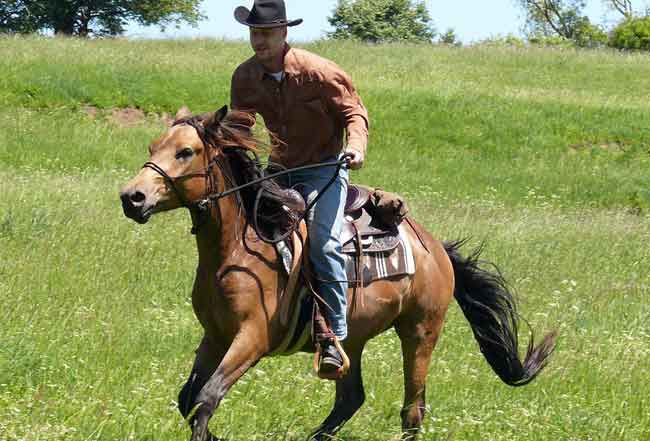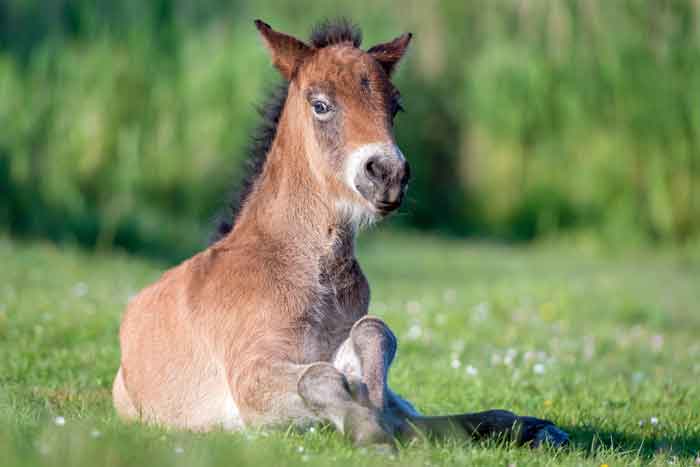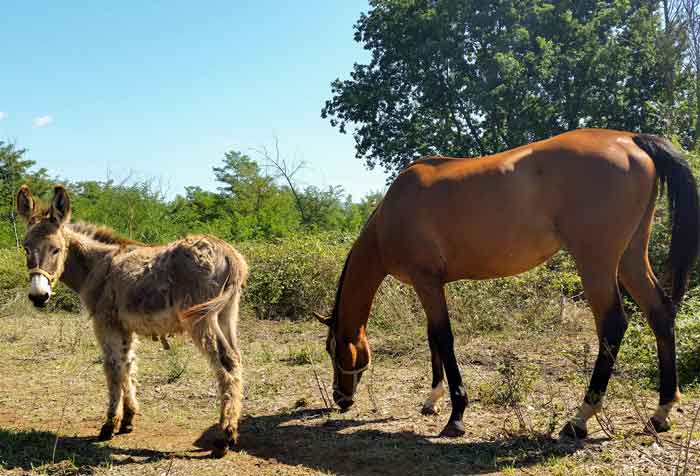A horse that you cannot stop is dangerous and should be taught how to stop. There can be several reasons for this (as we will look at).
How Do You Make A Horse Stop?
Here’s everything you need to know about how to stop a horse and how to learn it to stop when you want.
Table of Contents
Getting your horse to stop (when you want) is one of the first things you should teach a horse. Any broke horse will read your aides and quickly get to a full stop when you ask it to. It’s important because you need to be in full control of the horse at all times. It’s your responsibility as a rider to control the horse and make sure it stops when it should.
How To Stop A Horse That Won’t Stop

Possible Reasons A Horse Won’t Stop Moving
Some horses are more headstrong and will take more teaching in order to learn the basics.
It’s stubborn and green
When a horse won’t stop when asked to we are typically dealing with a green horse. A green horse means that the horse hasn’t been taught and trained properly yet.
It can also be a hot horse (hot-tempered) that doesn’t want to do what you tell it to. Some horses just take more training and practice before they are willing to let you be the master.
If this is the case, skip to the section where we suggest some good exercises you could do to make your horse learn how to stop.
It cannot hear you
Maybe the horse cannot hear you when you say “Whoa” to make it stop. In this case, do need to use the full stop (pull the reins) because you’re probably going fast or you are in a noisy environment.
You could also be dealing with an old horse that cannot hear too well. So make sure the horse knows exactly what you are communicating and use the reins if you have to.
It hasn’t been taught the cues
You need to teach the horse to stop whenever you say “Whoa”. This is one of the very first things you should teach the horse.
Don’t even pull the reins, just say “Whoa”.
But don’t expect a horse to know what the heck you are talking about, the first times you do this. This is not something that’s hardwired into the horse and even though they know how to stop (from nature’s side) they need to know exactly when YOU want it to stop.
Another way to stop your horse is by pulling the reins.
This is what we call a full stop in the horse world. It’s different from the whoa step because you can use it at high speeds and in places with a lot of noise (where the horse cannot hear you). It should typically be the second choice when you try to stop your horse if the first way doesn’t work.
Bits For Horses That Are Hard To Stop
Let’s start by clarifying one thing. It’s not the bit that will stop the horse but it plays an important role. It’s proper training from the handler that will teach the horse to come to a complete halt.
You shouldn’t yank the reins harder and harder in order to force the horse to stop because that will just hurt the horse.
Let’s take a look at what you can do regarding the bits in order to create better results.
Make sure the bit fits the size of the horse
If we’re talking about a very big horse can take a little more work to get it to stop. It’s not always easy to get a really big horse to stop if it is very excited about running.
But you shouldn’t blame this on the bit unless you are using a smaller bit.
But sometimes you will also find a normal-sized horse or even a small horse with a really big mouth. So, you need to measure the horse’s mouth to find a bit that fits it well.
This is also some things you can do with the veterinarian or a professional trainer as they will quickly be able to tell which size you need for the bit.
Make sure the horse is not afraid of the bit
If you have developed a habit of pulling the reins really hard whenever you want to force it to a stop, the horse might have become afraid of the bit in its mouth.
It’s not pleasant for the horse to have the bit pulled too hard against its teeth. Make sure to never do this and let the horse know (from experience) that you are not pulling hard on the reins in order to make him or her stop.
Some horses are moving too quickly and react to the smallest aides from you. Other horses, will take more practice and a little more firm grips in order to make them listen. This is what we call “behind the leg”.
Horse Won’t Stop In Canter
It’s not easy to get a horse to stop quickly from a canter.
There’s a good reason why horses prefer not to stop directly from a canter. This is simply because it requires a new a lot of muscle work from the horse to do a full stop directly from high-speed. It’s tough for the horse and it also tears on it.
Nonetheless, it’s really important to be able to do this.
Let’s first look at how are you should normally stop your horse when you two are in canter-mode.
Normally, you should aim for a transition from canter to trot and from trot to walk. This is much easier for the horse as it requires a lot of muscle work for the horse to do a stop directly from cantering.
Now that the horse is walking more slowly you should ask it to stop by saying “Whoa”.
It’s typically easier to get a horse to stop while walking or doing the trot. When we talking about getting a horse to stop from canter we need to make sure he or she knows exactly how to stop while walking and doing the trot first.
Start by learning how to stop walking and trotting
You should always start out by teaching the horse how to stop when walking and trotting.
This is much easier for the horse and it requires less work from you to do the canter stop once the horse knows how to do this.
As soon as he/she knows how to stop while walking or trotting we can start working on making her stop from a canter.
It’s important for the horse to know how to stop from the canter. But make sure you don’t do this too often because it’s hard on that horse. It’s much better to stop gradually by slowing the horse down through trotting and walking.
How to do a full-stop from canter
Now we know how to do a slow stop when the horse is going fast. But, as we talked about, we also need to be able to do a full stop directly from cantering when we have to.
When you’re going off at full speed and you need to do a sudden full stop (probably for safety reasons) you should use the reins to tell the horse to stop.
Let the horse know you want to stop by pulling gently in the reins and
How to stop from a gallop

You normally do this by sitting up more straight in order to force the horse toward the canter-rhythm. When you sit up more straight it becomes harder for the horse to continue in the galloping mode.
If he doesn’t follow your Carman’s at this point, you should kick him. Be careful if you’re using spurs and make sure to start out with a gentle kick. Then continue on to a harder kick to make him aware that this isn’t fun for you.
If you cannot make him/her stop from the gallop you should pull one side of the reins in order to make him/her go in circles.
After a while, the horse should get two more tired and start slowing down to a canter, then a trot, and finally come to a complete halt.
If none of these tips work you might want to consider a stronger bit. Some horses need more prompting and it’s “behind the leg” as we call it. They can be harder to work with because they did not respond as quickly and they require more aides and stronger signals from you.
Changing the bit, however, should not be your first option.
As we looked at above, the bit is not what is causing the horse to stop. It’s the training that teaches the horse to stop. But we need to make sure that the horse is actually sensing the bit and that it does indeed work. For a very big horse, you might consider a bigger bit.
Great Stopping Exercises For Horses
We have written a separate post with some great stopping exercises for horses. It’s really important that you nail this part pretty quickly so you can feel safer while riding the horse.
Here are the best and easiest stopping exercises for horses.
It’s also important for the safety of people around you when you ride outside the fences.
Remember, it’s always your responsibility to control the horse and you will be responsible for any damage it causes because you weren’t able to stop and control your horse.






